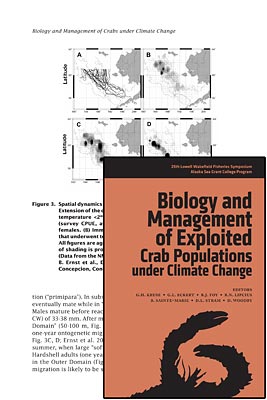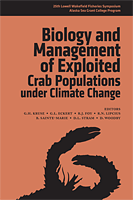
A Crab for all Seasons: The Confluence of Fisheries and Climate as Drivers of Crab Abundance and Distribution
D.A. Armstrong, P.S. McDonald, G.H. Kruse, A.H. Hines, and J.M. Orensanz
- Price: $1.65 Sale: $0.00
| Format | Price | |
|---|---|---|
| PDF download [1.9 MB] Bypass cart and download |
Free | Add to Cart |
Description
Abundance and distribution of crab stocks are affected by factors such as habitat quality, community structure, climate variability, and fishing that are interrelated in various ways. We explore the interplay of climate and fishing on crab populations by reviewing several well-known case studies. Snow crab (Chionoecetes opilio) in the eastern Bering Sea declined to about 10% of their abundance in the late 1990s. Concurrently, the stock underwent a dramatic distributional shift from southeast to northwest over the continental shelf. Contraction to the northwest during a warming phase perhaps resulted from an "environmental ratchet" whereby crab now occur in northerly areas of colder water, and a large predator guild may limit recruitment in southerly areas. Red king crabs (Paralithodes camtschaticus) declined significantly in Alaska following a climate regime shift, but fishing may have also adversely affected stocks. Recovery or ongoing depletion in different areas may reflect variable influence of climate and fishing as causative factors. Dungeness crab (Cancer magister) fluctuate widely in abundance and most hypotheses evoke climate-driven oceanographic processes regulating recruitment. The long-term demise of the central California fishery is ascribed to a decadal-long shift in timing of the spring transition. These case studies represent male-only fisheries, but an intriguing fishery that exploits both sexes exists for blue crab (Callinectes sapidus) along the U.S. east coast. Crab spawning stock abundance has declined more than 80% in the last decade and habitat degradation and fishing pressure on females appear primarily responsible. Based on our review, we ask: does climate trump fishing as the leading cause of change in distribution and abundance of fished crab populations?
Item details
- Item number: AK-SG-10-01a
- Year: 2010
- DOI: https://doi.org/10.4027/bmecpcc.2010.05


 This is part of
This is part of 
